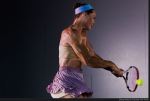In a past post I critiqued the NYT Magazine “Women Who Hit Hard” piece on female professional tennis players, and argued the expose was “soft core porn that had nothing to do with tennis”. While it is a strong statement, I stand by it, even when others disagree with me including Laura Pappano of Fairgamenews.com and a blogger on After Ellen. As always I welcome dialogue about this topic, and present here a critical perspective.
Some more specific reasons based on sport media scholarship to back up my claim are below which further expand why I think this piece is particularly problematic.
1. In sport media, scholars have used the term “ambivalence” (Duncan & Hasbrook, 1988) to describe how female athletes are routinely marginalized in the media. Ambivalence is manifest when two statements, or a picture and the text, are contradictory and conflicting. One seems positive and flattering, and the other has subtle or overt negative, sexualizing or belittling tones. The NYT piece is classic ambivalence. The article is quite positive and includes discussion of the depth of the women’s field, the increased global audience and prize money, and how much stronger and more fit female players are today. However, the accompanying slide show and particularly the video are what make the packaged piece ambivalent.
The 2 biggest pictures, both two-page color spreads (dare I say centerfolds?), are the most sexualizing. First, the picture of Kim Clijsters (included here) in gold dust has nothing to do with tennis. You can’t tell she is even a tennis player from looking at the picture. Second, the picture of Sam Stosur (also included here) has her playing in a nude tube top, a piece of equipment she would NEVER play a match in.
In fact last night watching the US Open, Clijsters played Stosur in the fourth round in a great match. So last night when I was watching the match, I thought to myself “Who is Stosur? I’ve never heard of her or seen her.” So I looked her up and found out she is an accomplished Aussie player. Is wasn’t until I sat down to write this blog and looked at the pics again that I put 2 and 2 together…the woman featured in this picture and the woman I watched last night were the same person! My point is, if we want to increase recognition of female athletes, this is NOT the way to do it. Emerging research indicates that sex does not sell women’s sport (I’ve written about this numerous times in the blog but to read one click here, or click on the “sexualization” blog tag)
The videos are also ambivalent. Yes they feature strong female athletes hitting the ball, which many think is really cool, but the slow motion, ballerina music, and the elongated shot time on the buttocks, crotch, and chest areas make it contradictory and sexualizing. Not to mention the make-up, hair down, and wearing of uniforms that most of the WTA players would dare not play.
2. Sport media scholars, study patterns of portrayals of female athletes, namely if the athlete is in uniform, on the court, and in action. The slides and videos do portray all three…kind of (I’ll expand on this point below).
3. Females athletes get so little coverage from sport and regular media, that when they are covered and it is in sexualized ways, it undermines their athletic achievements. In fact, in a recent report “Gender in Televised Sports” by two well-known sport media scholars, Professors Michael Messner and Cheryl Cooky, based on the data they illustrate that network sport coverage of female athletes is at an all time low–only 1.6% which was a decline from 6.3% in 2004!
Therefore, based on the data we rarely see females athletes, and when we do it often resembles soft core porn (or “muscle porn” as one person on the After Ellen blog dubbed it). Even though we disagree on this one, I agree with Laura Pappano’s statement below when she argues in her blog “ We have to find a way to consider athletic female bodies without automatically finding that because they are fit they are sex objects.” Unfortunately because we see athletic female bodies in primarily sexualized ways, it will be hard to tease out bodies, fitness levels, and athleticism without objectifying those same bodies. The NYT Magazine pieces only perpetuate the problem by again linking the female athleticism to sexualized bodies. What we have to get away from is the thinking pattern that female athletes and women’s sport is only interesting and marketable when their bodies are highlighted and sold. Highlight their athletic bodies in a natural setting–on the court (the real court, not a blacked out studio setting), in action (hitting real tennis balls not rolled in glitter), and in uniform (a real uniform in which certain body parts would not fly out or be exposed upon moving or hitting a real tennis ball).
To illustrate my point, imagine a similar NYT expose on ATP male professional players such as Nadal, Murray, Roddick, and Federer with their shirts off, chests oiled with gold glitter stuck to their muscles, glammed up, hair spiked, wearing super tight and short tennis shorts, lips slightly parted, hitting balls rolled in chalk or glitter to the same music. Wouldn’t that seem weird?
I invite further dialogue and counter arguments to this blog. What do you think?


